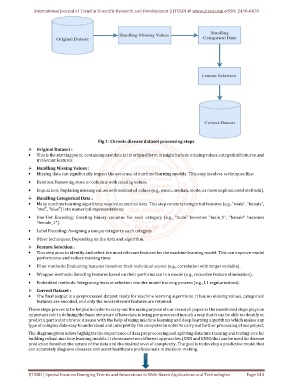Page 153 - Emerging Trends and Innovations in Web-Based Applications and Technologies
P. 153
International Journal of Trend in Scientific Research and Development (IJTSRD) @ www.ijtsrd.com eISSN: 2456-6470
Fig 1: Chronic disease dataset processing steps
Original Dataset :
· This is the starting point, containing raw data in its original form. It might include missing values, categorical features, and
irrelevant features.
Handling Missing Values :
· Missing data can significantly impact the accuracy of machine learning models. This step involves techniques like:
· Deletion: Removing rows or columns with missing values.
· Imputation: Replacing missing values with estimated values (e.g., mean, median, mode, or more sophisticated methods).
Handling Categorical Data :
· Many machine learning algorithms require numerical data. This step converts categorical features (e.g., "male", "female",
"red", "blue") into numerical representations:
· One-Hot Encoding: Creating binary columns for each category (e.g., "male" becomes "male_1", "female" becomes
"female_1").
· Label Encoding: Assigning a unique integer to each category.
· Other techniques: Depending on the data and algorithm.
Feature Selection :
· This step aims to identify and select the most relevant features for the machine learning model. This can improve model
performance and reduce training time:
· Filter methods: Evaluating features based on their individual scores (e.g., correlation with target variable).
· Wrapper methods: Selecting features based on their performance in a model (e.g., recursive feature elimination).
· Embedded methods: Integrating feature selection into the model training process (e.g., L1 regularization).
Correct Dataset :
· The final output is a preprocessed dataset ready for machine learning algorithms. It has no missing values, categorical
features are encoded, and only the most relevant features are retained.
These steps proves to be helpful in order to carry out the main purpose of our research paper as the mentioned steps plays an
important role in defining the basic structure of how data is being preprocessed in such a way that it can be able to identify or
predict a particular chronic disease with the help of using machine learning and deep learning algorithms which makes any
type of complex data easy to understand and interpret by the computer in order to carry out further processing of our project.
The diagram given below highlights the importance of data preprocessing and splitting data into training and testing sets for
building robust machine learning models. It showcases two different approaches (CNN and KNN) that can be used for disease
prediction based on the nature of the data and the desired level of complexity. The goal is to develop a predictive model that
can accurately diagnose diseases and assist healthcare professionals in decision-making.
IJTSRD | Special Issue on Emerging Trends and Innovations in Web-Based Applications and Technologies Page 143

